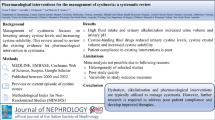Abstract
Introduction
Cystinuria is an inherited disease characterized by increased urinary cystine excretion and recurrent cystine stones. Current treatment regimens have limited effectiveness in preventing stone recurrence and are often poorly tolerated. The aim of this study was to evaluate the effect of tolvaptan, a vasopressin receptor 2 (V2) antagonist, on cystine stone volume in mice with cystinuria.
Materials and methods
Tolvaptan (0.4 mg per mouse) or placebo was delivered by gavage daily for 30 days. Urinary amino acids and cystine stones were analyzed to assess drug efficacy in preventing l-cystine stone growth using several analytical methods. Data were entered into SPSS and analyzed by paired sample T test. p value < 0.05 was considered significant.
Results
Compared with control group, the liquid intake and urine volume in tolvaptan-treated mice were significantly increased. The urinary cystine concentrations in group tolvaptan was lower than the baseline concentration before the experiment. After treatment, mice treated with tolvaptan had significantly delayed stone growth, exhibited lower overall stone volume accumulation, compared with control group. The increased stone volume of tolvaptan group was less than control group (8.00 ± 4.93 mm3 vs 27.90 ± 4.48 mm3, p < 0.001). The serum creatinine in the control group (11.75 ± 1.634 μmol/L) was higher than that in the tolvaptan group (7.625 ± 1.401 μmol/L) (p = 0.0759). In addition, tolvaptan significantly inhibited the formation and growth of stones in mice after cystolithotomy.
Conclusion
The present study indicated that tolvaptan’s efficacy in preventing l-cystine stone growth through increased liquid intake and urine volume of cystinuric mice.




Similar content being viewed by others
References
Knoll T, Zollner A, Wendt-Nordahl G et al (2005) Cystinuria in childhood and adolescence: recommendations for diagnosis, treatment, and follow-up. Pediatr Nephrol 20(1):19–24
Thomas K, Wong K, Withington J et al (2014) Cystinuria-a urologist’s perspective. Nat Rev Urol 11(5):270–277
Streeper NM, Wertheim ML, Nakada SY et al (2017) Cystine stone formers have impaired health-related quality of life compared with noncystine stone formers: a case-referent study piloting the Wisconsin stone quality of life questionnaire among patients with cystine stones. J Endourol 31(S1):S48–s53
Torres VE, Chapman AB, Devuyst O et al (2017) Tolvaptan in later-stage autosomal dominant polycystic kidney disease. N Engl J Med 377(20):1930–1942
de Boer H, Roelofsen A, Janssens PM (2012) Antidiuretic hormone antagonist to reduce cystine stone formation. Ann Intern Med 157(6):459–460
Chebib FT, Perrone RD, Chapman AB et al (2018) A practical guide for treatment of rapidly progressive ADPKD with tolvaptan. J Am Soc Nephrol 29(10):2458–2470
Cheungpasitporn W, Erickson SB, Rule AD et al (2016) Short-term tolvaptan increases water intake and effectively decreases urinary calcium oxalate, calcium phosphate and uric acid supersaturations. J Urol 195(5):1476–1481
Peters T, Thaete C, Wolf S et al (2003) A mouse model for cystinuria type I. Hum Mol Genet 12(17):2109–2120
Feliubadalo L, Arbones ML, Manas S et al (2003) Slc7a9-deficient mice develop cystinuria non-I and cystine urolithiasis. Hum Mol Genet 12(17):2097–2108
Torres VE, Higashihara E, Devuyst O et al (2016) Effect of tolvaptan in autosomal dominant polycystic kidney disease by CKD stage: results from the TEMPO 3:4 trial. Clin J Am Soc Nephrol 11(5):803–811
Acknowledgements
This work was financed by grants from the 1.3.5 project for disciplines of excellence, West China Hospital, Sichuan University (ZY2016104) and Department of Science and Technology of Sichuan Province (2018SZ0168).
Author information
Authors and Affiliations
Contributions
JW and PH: protocol/project development, data management, and manuscript writing/editing. YJB and YT: protocol/project development, data analysis, and manuscript writing/editing. YJB, YT, JHW, XMW, DHC and ZHW: data collection or management; JW, YJB, YT, XMW, JHW, and ZHW: revised the manuscript. All authors read and approved the final manuscript.
Corresponding author
Ethics declarations
Conflict of interest
The authors of this study disclose no conflicts of interest. This study was no funded in anyway by the manufacturers of tolvaptan.
Additional information
Publisher's Note
Springer Nature remains neutral with regard to jurisdictional claims in published maps and institutional affiliations.
Rights and permissions
About this article
Cite this article
Bai, Y., Tang, Y., Wang, J. et al. Tolvaptan treatment of cystine urolithiasis in a mouse model of cystinuria. World J Urol 39, 263–269 (2021). https://doi.org/10.1007/s00345-020-03166-3
Received:
Accepted:
Published:
Issue Date:
DOI: https://doi.org/10.1007/s00345-020-03166-3




